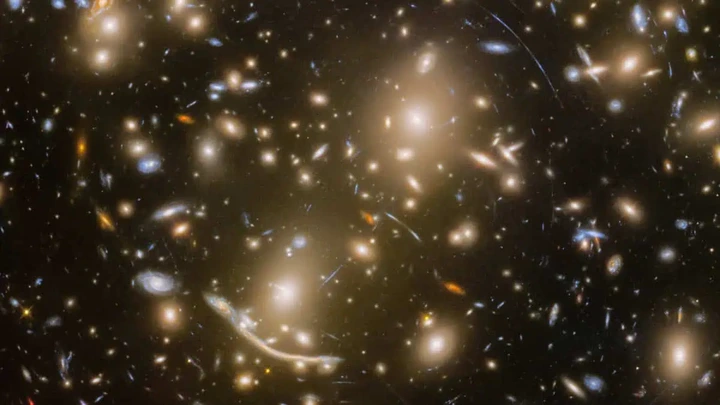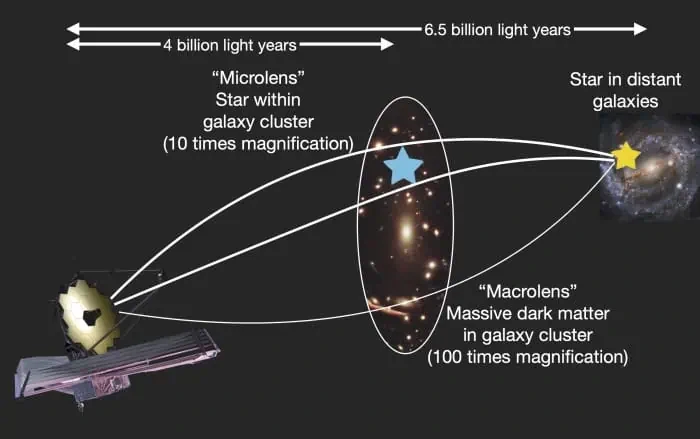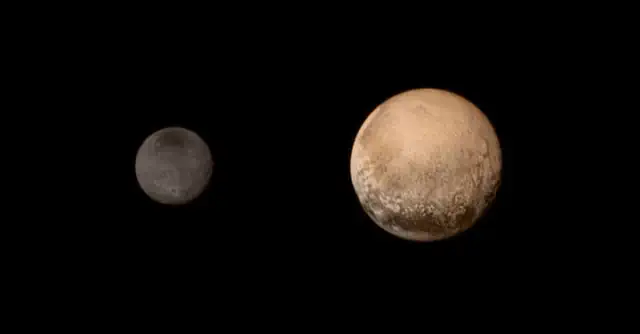The research team studied a galaxy located approximately 6.5 billion light-years away from Earth, dating back to a time when the universe was only half as old as it is today.
A global group of astronomers has identified more than 40 distinct stars in a galaxy situated 6.5 billion light-years from Earth. This finding is remarkable, as it marks the first time that over 40 stars have been found in a single galaxy; previous studies usually uncovered only one or two stars in similar galaxies.

View pictures in App save up to 80% data.
For decades, astronomers have sought to study distant galaxies with the same detail as our cosmic neighborhood. But distance doesn’t really work that way. The vastness of space reduced these far-off clusters to blurry patches of light. But researchers have found a clever workaround, thanks to the combined power of NASA’s James Webb Space Telescope (JWST) and an extraordinary cosmic alignment.
“To us, galaxies that are very far away usually look like a diffuse, fuzzy blob,” said Yoshinobu Fudamoto, an assistant professor at Chiba University in Japan and a visiting scholar at the University of Arizona’s Steward Observatory and study lead of the paper published in Nature Astronomy. “But actually, those blobs consist of many, many individual stars. We just can’t resolve them with our telescopes.”
However, thanks to a phenomenon predicted by Einstein—gravitational lensing—coupled with JWST’s extraordinary detection power, astronomers are now privy to sights once thought unattainable.
Seth Cohen, an associate research scientist at Arizona State University's School of Earth and Space Exploration and co-author of the study, remarked, "I am truly astonished by the various ways gravitational lensing has proven to be an invaluable tool for investigating a range of astrophysical phenomena."

View pictures in App save up to 80% data.
The Dragon Saga
Much of the recent success used a cosmic effect triggered by an intervening galaxy cluster—coined Abell 370. Due to its gravitational attraction, this galaxy bends and magnifies the light from a more distant galaxy, called the Dragon Arc for its gracefully elongated spiral shape.
The Dragon Saga can now be imaged so well that astronomers can even identify many stars individually, measuring their brightness, temperature, and possible evolutionary stage. Because this cluster is so old, these insights shed light on how star formation may have differed when the universe was just half its current age. Researchers also spotted several “rogue” stars, that float around the universe outside galaxies.
“Within the galaxy cluster, numerous stars drift freely, not gravitationally tied to any particular galaxy,” explained co-author Eiichi Egami, a research professor at Steward Observatory. “When one of these stars crosses the path of a background star from a distant galaxy as viewed from Earth, it functions as a microlens, complementing the overall microlensing effect produced by the galaxy cluster itself.”
However, the galaxy cluster’s macrolensing—powerful though it is—still cannot by itself produce such astonishing detail. That is where microlensing comes in.
Focusing in on the cosmos
Microlensing is a technique used in astronomy to detect distant objects such as planets and stars by observing the way their gravitational field alters the light from a star located behind them. When one star passes in front of another from our perspective, the intervening star distorts the light from the background star, causing it to appear more luminous.
Astronomers observed a fascinating phenomenon by analyzing JWST images captured in December 2022 and December 2023. They discovered that numerous stars appeared to flicker into view and then gradually dim across the vastness of the Dragon Arc.
Data from the study reveals that many of these magnified stars are red giants or supergiants—massive, luminous stars that normally remain invisible to us at cosmological distances. These stars have surface temperatures of roughly 3,000 to 4,000 Kelvin, implying they are mature, cooler stars capable of releasing copious amounts of light in the infrared.
These enlarged stars symbolize more than a mere advancement in observation. They have the potential to act as guiding lights for one of the most significant challenges in contemporary physics: uncovering the characteristics and arrangement of dark matter.
Journeying through the universe via the perspective of dark matter
Research on microlensed stars within the Dragon Arc has uncovered fresh perspectives on dark matter, an enigmatic substance that appears to be widespread across the cosmos. By detecting stars that are magnified due to the gravitational effects of the Abell 370 galaxy cluster, scientists can investigate dark matter on scales smaller than entire galaxies. These stars, positioned close to critical curves where gravitational lensing is at its peak, enable researchers to chart the arrangement of dark matter subhaloes—tiny, concentrated bundles of dark matter that alter the trajectories of light.
Certain microlensing events have been observed in surprising locations, indicating the existence of dark matter structures that do not align with existing models. This finding poses challenges to our comprehension of dark matter's behavior and distribution, providing an innovative method to evaluate conflicting theories regarding its composition, including the possibility that it is made up of compact objects or spread-out particles.
Through the observation of these stars' variability, researchers are able to enhance lensing models and obtain a more accurate understanding of dark matter's influence in the cosmos. This research highlights the capabilities of time-domain observations conducted by the JWST, paving the way for new avenues to investigate the elusive matter that makes up a substantial portion of the universe's mass. This represents a crucial advancement in the quest to uncover the secrets of dark matter.
As astronomers refine their methods and use repeated observations, they may uncover entire populations of distant stars, possibly even catch glimpses of Population III stars—the first generation formed after the Big Bang. While the Dragon Arc discovery is extraordinary in itself, it hints that we are only beginning to exploit JWST’s capabilities for time-domain studies.
“Back in 2018, when we speculated that Webb might be able to observe stars in distant galaxies individually, I never imagined it would capture them in such abundance,” remarked Rogier Windhorst, ASU regents professor and co-author of the study. “Now, we find ourselves witnessing these stars flickering in and out of images captured just a year apart, reminiscent of fireflies in the dark. Webb never ceases to astonish us.”









